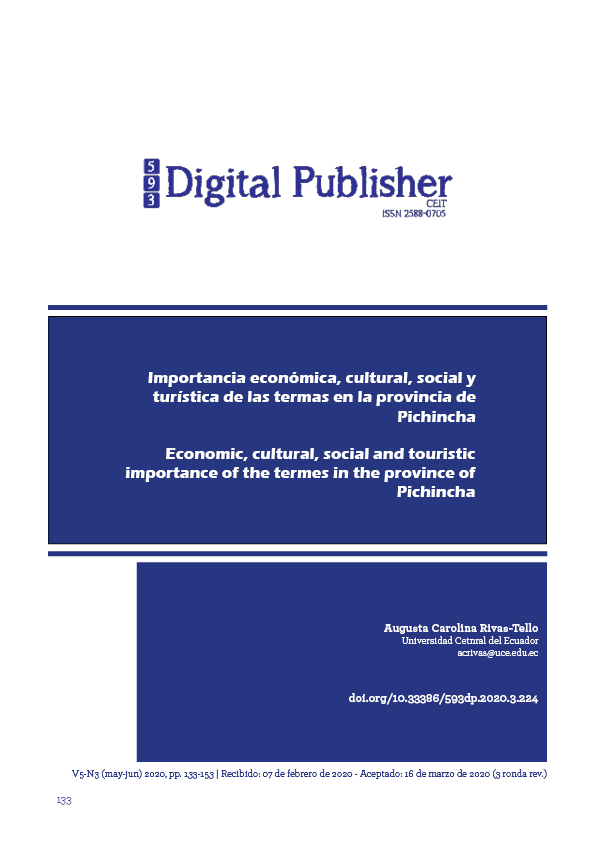Economic, cultural, social and touristic importance of the termes in the province of Pichincha
Main Article Content
Abstract
The quality of life and availability of time increases the demand for leisure and recreation. Among the alternatives, it is worth highlighting health tourism, which is gaining extraordinary relevance (Prado, 2000). This tourist segment is being driven towards promotion and development, which is confirmed as an interesting tourist specialisation. This investigation begins with a general diagnosis in the different cantons of the province of Pichincha that have thermal waters as a tourist attraction, a high influx of national and foreign visitors, adequate infrastructure and easy access for tourists. The search for rest and physical well-being of the visitors by taking advantage of the mining-medicinal qualities of the water, becomes a place of leisure since from these spas are promoted activities such as sports and gastronomic tasting typical of a rural tourism
Downloads
Article Details
1. Derechos de autor
Las obras que se publican en 593 Digital Publisher CEIT están sujetas a los siguientes términos:
1.1. 593 Digital Publisher CEIT, conserva los derechos patrimoniales (copyright) de las obras publicadas, favorece y permite la reutilización de las mismas bajo la licencia Licencia Creative Commons 4.0 de Reconocimiento-NoComercial-CompartirIgual 4.0, por lo cual se pueden copiar, usar, difundir, transmitir y exponer públicamente, siempre que:
1.1.a. Se cite la autoría y fuente original de su publicación (revista, editorial, URL).
1.1.b. No se usen para fines comerciales u onerosos.
1.1.c. Se mencione la existencia y especificaciones de esta licencia de uso.
References
Arévalo Pacheco, G. J., & Guerrero García Rojas, H. R. (2014). Turismo de salud por medio del aprovechamiento de aguas termales Caso de la Ruta de la Salud Michoacán. ECONOMÍA Y SOCIEDAD, 121.
Bonfada, P., G., J. (2011). El turismo de salud y el uso terapéutico del agua. En Estudios y Perspectivas en Turismo (Vol. 20, pp. 462-467). http://www.scielo.org.ar/pdf/eypt/v20n2/v20n2a11.pdf
Burbano, N., Becerra, S., & Pasquel, E. (2013). Aguas Termoninerales en el Ecuador. INAMHI.
Cumbria Bienestar. (2015). CUMBRIA BIENESTAR. Ven Relajate y Disfruta. http://www.cumbriabienestar.es/2013/12/
Dressel, L. (1876). Estudio sobre algunas aguas minerales del Ecuador. Imprenta Nacional.
Hernández Días, E. A. (1982). Planificación Turística, un enfoque metodológico. http://unrn.edu.ar/blogs/pt/files/2013/03/1-Hernández-PlanifTur-reimpr-1991.pdf
Hispana. (2016). Las Termas Romanas. https://termasromanashispania.wordpress.com/2016/03/01/introduccion/
INAMHI. (2013). Agua termonineral en el Ecuador [Map].
INNATIA. (2019). INNATIA. LA VANGUARDIA. http://www.innatia.com/s/c-aguas-termales/a-aguas-termales-en-latinoamerica-6233.html
Jarrassé, D. (2002). EN EL NACIMIENTO Y DESARROLLO DEL TURISMO EN EUROPA EN EL SIGLO XIX. Universidad Michel de Montaigne-Bordeaux, 33-49.
Ledhesma, M. (2018). Tipos de turismo: Nueva clasificación. https://www.academia.edu/35613794/Tipos_de_Turismo_nueva_clasificaci%C3%B3n
Melgosa Arcos, F. J. (2000). Turismo de salud: Termalismo y balnearios. III Congreso de turismo universidad y empresa, 359-386.
Molina, S. (2006). El Posturismo Turismo y posmodernidad. Trillas. http://bauldelturismo.com/wp-content/uploads/2019/01/El-Posturismo-Sergio-Molina.pdf
Muñoz, J. (1957). Compendio de Hidrología General y Aplicada.
Naciones Unidas. (1985). LOS RECURSOS HIDRICOS DE AMERICA LATINA Y EL CARIBE Y SU APROVECHAMIENTO (p. 105). Naciones Unidas. https://repositorio.cepal.org/bitstream/handle/11362/8494/S8500028_es.pdf?sequence=1&isAllowed=y
Napoleón Burbano, Becerra, S., & Pasquel, E. (2011). Introducción a la Hidrología del Ecuador (INAMHI).
Pardo, C. (2017). Termalismo y sostenibilidad. http://www.eixoatlantico.com/index.php/es/oc-noticias/oc-opinion/item/2772-termalismo-y-sostenibilidad
Reverter, J. (2005). Estaciones termales en zonas rurales, servicios asociados y titulaciones oficiales. En Gestión Deportiva, Ocio y Turismo (Vol. 4, pp. 59-69). https://repositori.udl.cat/bitstream/handle/10459.1/46406/014381.pdf?sequence=1&isAllowed=y
Torrejón, A. (2004). Glosario Técnico de Terminología Turística. Universidad Nacional de la Patagonía. https://www.region.com.ar/productos/semanario/archivo/672/turismo672.htm

